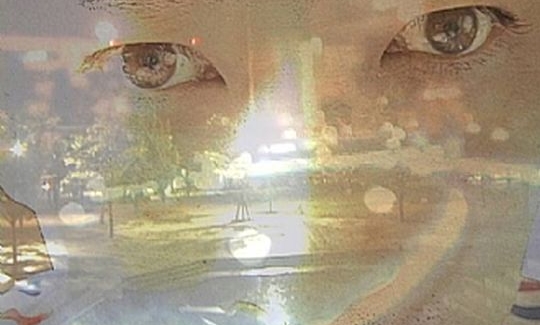Contemporary Japanese Video Art
Mu by Hiroyoki Oki Behind the Scenes by Ken Ikeda
More info:
046030800Mu by Hiroyoki Oki
While still a student of architecture at Tokyo University, Oki (b. 1964) began creating videos that gave visual expression to his abstract architectural concepts. He was immediately recognized as a promising artist, and won several prizes for his creations. He studied photography at the Image Forum Institute in Tokyo, but his interest in architecture has never ceased to complement his work. He believes that architecture and cinematography are two modes of exploring the social arena and of experiencing it.
Oki makes his films in Japan and abroad. He starts with a planned scenario, but then ignores the plan and lets the work develop naturally and spontaneously. Using a portable camera he tries to expose the rhythms of life in his work. His artistic style ranges from documentation to illusion. In his video Mu (MU 623, MX 2003-2005), filmed at various locations in Tokyo, Kagawa, and China, he creates a melange of space and time: transparent images of daily life move through different planes of the space. The film does not develop as the audience expects it to - past, present and future are all mixed together into a ‘living' space-time continuum. The images seem to melt into each other, and the artist scrutinizes them through different "layers", examining the relationship of man to his environment by linking casual encounters with other events occurring at the same moment. Oki defines himself as an architect: "The architecture that interests me is a comprehensive expression that encompasses human beings and their relationship with their environment" he says. "In this film I deal with all these matters - people, objects, time. This is a very architectural approach."
The term "Mu" means "nothing" or "naught", testifying to the emptying of consciousness, recognition of self-awareness, a process leading to Buddhist enlightenment. In this meditative process of emptying, nothing in the universe remains but the metaphysical concept of it - a clear, unbounded vision without the limitations of awareness. By means of these interwoven images, the web of life in which everything intermingles, Oki succeeds in conveying his ideas.
Oki's video-art has been presented at many film festivals, at Sundance and Rotterdam, and at museums in the United States, Sweden, Germany, France, Switzerland, Canada, and elsewhere. His work Na-Mo was filmed in Israel, the Palestinian territories, Turkey, Nepal, Tibet and Japan.
Acknowledgements:
The video is presented courtesy of Mr. Urano Mutsumi and the artist.
Behind the Scenes by Ken Ikeda
Ken Ikeda (b. 1964) is a Japanese video artist and composer. His video work Behind the Scenes includes his own melodies among extracts from some 100 soundtracks of old movies made by famous Japanese directors before and after WWII. Among those directors are: Yasujiro Ozu (1903-1963), Mizoguchi Kenji, Shimizu Hiroshi, Naruse Mikio, and Kawashima Yuzo. Ikeda also integrates short visual passages from their films, of figures or areas slowly traversing the screen.
The images are grainy, and the picture is not focused. The pale blue background conveys a sense of isolation. Ikeda says that Behind the Scenes deals with the area between the revealed and the concealed. His aesthetic resembles that of the founder of the Noh Theatre, Zeami Motokyo (ca. 1363-1443).
Zeami was one of the first to describe "ma" (the interval between things) as an aesthetic value in Japanese art. In his essay "Kakyo" ("The Mirror of the Flowers"), written in 1424, in which he defines the principles of acting, and which may help to explain the contemporary work of Ken Ikeda, Zeami wrote: "Sometimes the audience asserts that the ‘motionless' instants are the most pleasing. This is an art in which the artist keeps his secret. The various gestures are art created by the body, including periods of immobility (hima) . If we examine the reasons why these moments are so pleasing, we find that it depends on the spiritual power of the actor who constantly attracts the attention (of the audience)..." This sense of the actor's internal control is revealed in a refined manner, giving pleasure. But it is not desirable that it should be obvious. If it is apparent to the audience, it becomes movement rather than "un-movement". The gestures prior to and after the motionless pauses must derive from a state of mu-shin - "un-being" in which the artist succeeds in concealing his intentions even from himself. Ikeda also believes that the "gray area" (between black and white) is where the "real" work is to be found.
In Ken Ikeda's opinion, sound is not merely musical accompaniment to a film. Music is the force that drives the images in his work. In order to sharpen this experience, he intentionally relinquishes the story-line. As in the Noh creations in which there is no action and the actors move in "slow motion", discarding narrative and minimalising movement leave Ikeda's work with almost empty spaces intended to awaken an experience or memory in the spectator, out of which s/he weaves his/her own story. This private experience varies from person to person, and may even change in the same person from time to time. Thus the activity of the spectator is germane to enjoyment of the work. Restraint and minimalism are the essential elements of the traditional Japanese aesthetic of Emptiness, intended, among other things, to create a sharpened experience in the spectators who, to some extent, are themselves its creators.
Ikeda also composes music for others, including the contemporary Japanese artist Mariko Mori. His works have been presented in Japan, Germany, England, Italy, South Korea, Australia and elsewhere.
Acknowledgements:
The video is presented courtesy of Mr. Urano Mutsumi of the SCAI THE BATHHOUSE Gallery, Tokyo.

